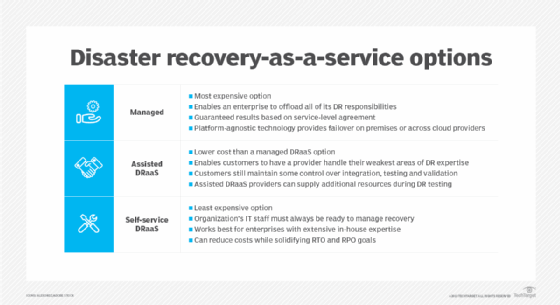
You can more - Fotolia
3 types of DRaaS: Which approach is best?
Your disaster recovery-as-a-service strategy needs to consider not only business needs but your IT staff's capabilities. Options range from full-on help to do-it-yourself DRaaS.
You've decided that you want to implement disaster recovery as a service, but what are your options? It all depends on your budget, as well as the time you want to allocate to oversight and testing. You might want to go completely hands-off with a managed DRaaS approach where everything is done for you. An assisted DRaaS approach -- not offered by all providers -- has experts that supply help only when it's needed. And if you have the internal expertise and bandwidth, a self-service DRaaS offering that enables you to create your own strategy might be your best bet.
Let's drill into these three major DRaaS provider options, what they offer and points to ponder with each approach.
Managed DRaaS
With managed DRaaS, an enterprise can offload virtually all of its DR responsibilities to an outside party. The burden of protecting infrastructure resources, including cloud and on-premises systems, as well as DR testing, validation and operation, shifts from the customer to the service provider.
"There's guaranteed results based on service-level agreements," explained Rawlinson Rivera, CTO, global field at Cohesity Inc., a hyper-converged storage firm. "However, it's still a shared responsibility in the sense that you need to be continuously engaged and communicating infrastructure, application and services changes to the provider for it to be able to effectively do its job, [which is] responding to a failure."
Managed DRaaS providers are able to offer a platform-agnostic technology that can provide failover for physical or virtual hardware within a customer's on-premises data center or across any range of cloud providers, said Thomas Burns, CTO of Green House Data, a data center and managed services provider. "The primary benefit is little to no effort on the part of your IT staff," he noted. "The solution is provided and tested completely as a service, so you are guaranteed a successful recovery in the event of a disaster."
Assisted DRaaS
The benefits of assisted DRaaS are similar to those of a fully managed approach. "You still get to leverage the expertise of the provider, and the administrative burden of managing the solution is lower than a traditional [DRaaS] deployment," observed Ned Bellavance, director of cloud solutions at Anexinet, a technology and business management consulting firm. Yet the customer still maintains a level of control over the integration, testing and validation of the DR offering.
"That can be good in the case of highly customized applications that have unique needs that would be difficult to explain to a service provider," Bellavance said. Assisted DRaaS providers can also supply additional resources during the DR testing phase, enabling a customer to properly execute testing without pulling full-time teams away from their ongoing projects.
Assisted DRaaS providers can add value by providing consultation and advice on optimizing disaster recovery procedures. They often have a team of engineers that you can rely on for assistance, if required, noted Jared Moore, a platform engineer at database management services provider N4Stack.
Perhaps the most compelling benefit of assisted DRaaS is that the approach enables customers to identify their weakest DR capabilities and then pay the provider to handle those specific services, Cohesity's Rivera said.

Self-service DRaaS
Doing it yourself is always the least expensive option -- until it's not. "While this model offers unparalleled flexibility, you are entirely on your own with responsibility for your DR solution," explained Ian McClarty, president and CEO of PhoenixNAP, a global IT services provider. This includes planning, testing, ongoing management and, of course, managing any failover events. "This model requires IT staff [to be] at the ready to manage recovery when needed," he noted.
Self-service DRaaS works best for enterprises with extensive in-house expertise and proper program management capabilities already in place to plan, deploy and execute a DRaaS strategy, advised Manoj Nair, CEO of HyperGrid, a cloud management platform provider. The approach requires the customer to have a thorough understanding of its own IT landscape, applications and services.
"It also requires knowledge of the relationships with assets, such as storage, compute and networking, as well as the interdependencies between them," he said. With proper automation at the IaaS level and prioritization of the base application services necessary to sustain the business, self-service DRaaS can help enterprises reduce costs while solidifying recovery time objectives and recovery point goals.
All DR is good DR, since one never knows exactly when a disaster will strike, N4Stack's Moore observed. "However, when it comes to choosing your DR services, it's important to weigh your business needs and capabilities, as there is no one-size-fits-all solution."






